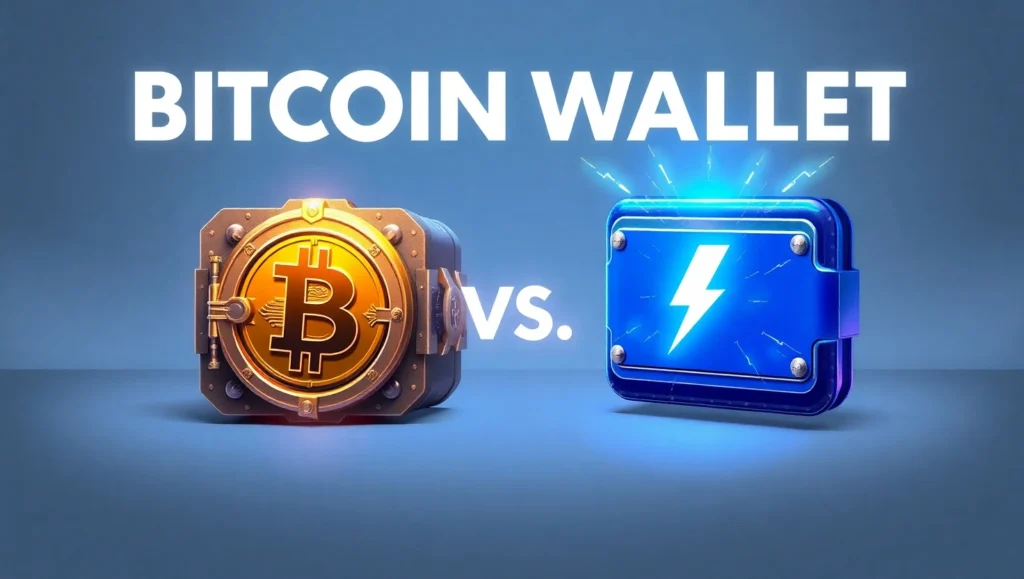The world of cryptocurrency is changing fast. With more people using Bitcoin and other digital coins, it’s key to know the difference between old-school Bitcoin wallets and new Lightning Network wallets. This article will help you understand the good and bad of each, so you can choose the right one for you.
Whether you’re new to crypto or have been around for a while, picking the right wallet can be tough. By learning about Bitcoin and Lightning Network wallets, you’ll know what each can do. This knowledge will help you pick the best wallet for managing your digital money.
Understanding Bitcoin and Lightning Network Fundamentals
To understand different wallet types, we need to know the basics of Bitcoin and the Lightning Network. The Lightning Network is a second-layer solution built on Bitcoin. It helps make Bitcoin transactions faster and cheaper.
What is the Bitcoin Base Layer
The Bitcoin base layer is the core network that tracks and checks all Bitcoin transactions. It uses blockchain technology to keep a safe, open, and clear record of digital deals. The Bitcoin protocol sets the rules for the network, making sure everything is fair and correct.
How Lightning Network Works as a Second Layer
The Lightning Network is a Layer 2 solutions built on top of Bitcoin. It’s made to solve Bitcoin’s scaling problems. It allows for quick and cheap transactions off the main Bitcoin blockchain. This makes the Bitcoin system more efficient.
The Need for Different Wallet Types

With Bitcoin and the Lightning Network together, we need different wallets. Each wallet is made to work well with its layer. This meets the varied needs and habits of Bitcoin users. It makes sure the Bitcoin and Lightning systems serve everyone well.
Traditional Bitcoin Wallets Explained
Traditional Bitcoin wallets are key for managing your digital currency. They can be hardware, software, or paper-based. These wallets keep your private keys and public addresses safe, letting you send, receive, and manage your Bitcoin.
Hardware wallets are physical devices that keep your private keys offline. This adds an extra layer of security against online threats. They look like USB drives and are easy to use. Software wallets, however, are apps on your computer or mobile device. They offer a digital space for storing and managing your Bitcoin.
Traditional wallets let you control your private keys. Private keys are unique digital signatures that unlock your Bitcoin. By keeping these keys, you own and control your assets fully. Custodial wallets, where someone else holds your keys, can be less secure and less accessible.
To send Bitcoin, you give the recipient’s public address. Your wallet signs the transaction with your private key. This makes the transfer secure and authentic. This process is key to Bitcoin’s decentralized and trustless nature.
| Wallet Type | Key Management | Transaction Process | Use Cases |
| Hardware Wallet | Private keys stored offline on a physical device | Transactions signed on the device | Long-term storage, high-security storage |
| Software Wallet | Private keys stored on your computer or mobile device | Transactions signed on your device | Daily spending, easy access, mobile usage |
| Paper Wallet | Private keys printed on a piece of paper | Transactions signed using the printed private key | Long-term storage, high-security storage |
Knowing about different traditional Bitcoin wallets helps users choose the best one. Whether it’s hardware, software, or a mix, understanding your options is key.
Read More : Playground For Emerging Technologies for Innovators
Lightning Network Wallets: A Comprehensive Overview
The Bitcoin network is growing, and we need better payment solutions. The Lightning Network is a second-layer protocol that makes instant payments easy and cheap. It also helps with microtransactions. Let’s explore what Lightning Network wallets offer, including channel management and liquidity, and check out some top choices.
Core Features of Lightning Wallets
Lightning Network wallets work well with the Lightning protocol. They make instant payments simple and manage payment channels smoothly. These wallets also have cool features like rebalancing channels and swapping liquidity, keeping Bitcoin’s security and decentralization.
Channel Management and Liquidity
Managing payment channels is key for Lightning Network wallets. Users need to spread their funds wisely to ensure smooth microtransactions. These wallets come with tools to help users keep their channels balanced and efficient.
Popular Lightning Wallet Options
- Blue Wallet: A user-friendly mobile wallet that offers a range of Lightning Network features, including channel management and support for instant payments.
- Phoenix Wallet: A non-custodial, open-source Lightning wallet known for its intuitive interface and advanced functionality, such as channel liquidity management.
- Muun Wallet: A multi-purpose wallet that seamlessly integrates both Bitcoin and Lightning Network features, providing a unified experience for users.
| Confirmation Times | Key Features | Supported Platforms |
| Blue Wallet | Channel management, instant payments, low fees | iOS, Android |
| Phoenix Wallet | Non-custodial, channel liquidity management, microtransactions | iOS, Android |
| Muun Wallet | Integrates Bitcoin and Lightning, payment channels, instant payments | iOS, Android |

Bitcoin Wallet vs Lightning Wallet: Key Differences
Choosing between a Bitcoin wallet and a Lightning wallet affects how you manage your digital assets. Both are used for storing and transferring cryptocurrencies. Yet, they have distinct differences.
Bitcoin wallets handle on-chain transactions. These are recorded on the Bitcoin blockchain and need network confirmations. This can take 10 to 60 minutes, depending on the network and the transaction fee.
Lightning wallets make off-chain payments possible through the Lightning Network. These transactions are fast and have lower transaction fees than on-chain ones. However, setting up and maintaining Lightning wallets requires extra effort.
| Feature | Bitcoin Wallet | Lightning Wallet |
| Transaction Processing | On-chain transactions | Off-chain payments |
| Confirmation Times | 10 to 60 minutes | Instant |
| Transaction Fees | Higher fees | Lower fees |
Deciding between a Bitcoin wallet and a Lightning wallet depends on your needs. Bitcoin wallets are good for big, less frequent transactions. Lightning wallets are better for small, frequent payments. Knowing the differences helps you choose wisely and manage your cryptocurrencies better.
Security Considerations for Both Wallet Types
Managing your digital assets means keeping your wallet secure. Both Bitcoin and Lightning Network wallets have their own security features. Knowing about cold storage, hot wallet security, backup strategies, and common risks helps you choose the right wallet.
Cold Storage vs. Hot Wallet Security
Cold storage wallets, like hardware wallets, are super secure. They keep your private key management offline, away from the internet. This makes them less vulnerable to cyber attacks. On the other hand, hot wallets are always online, making them easier to use but more at risk of hacking.
Backup and Recovery Methods
Every wallet needs a good backup and recovery plan. Seed phrases, a set of recovery words, are key for both Bitcoin and Lightning Network wallets. They let you get back into your wallet if you lose or damage it. Also, multi-signature wallets add an extra layer of security by needing more than one person to approve transactions.
Common Security Risks
Even with strong wallet encryption, there are dangers like phishing, malware, and theft. Stay safe by updating your wallet, using two-factor authentication, and being careful with unknown websites or apps.
Understanding the security of Bitcoin and Lightning Network wallets helps you choose wisely. This ensures your digital assets are safe, based on your risk level and needs.
Transaction Speeds and Fee Comparison
Transaction speed and fees are key when using blockchain. The Bitcoin network and the Lightning Network have different benefits and drawbacks.
The Bitcoin main blockchain is secure and decentralized. But, it faces issues with network congestion and confirmation times. When the mempool is full, transactions take longer. This can make routing fees higher as people try to get their transactions done first.
The Lightning Network is a second layer solution. It makes transactions fast and cheap by using off-chain payment channels. This reduces the effect of network congestion and speeds up confirmation times.
| Metric | Bitcoin Base Layer | Lightning Network |
| Confirmation Times | 10 minutes to 1 hour+ | Instant or near-instant |
| Fees | Variable, can be high during network congestion | Negligible, often less than a penny |
Choosing between a traditional Bitcoin wallet and a Lightning Network wallet depends on your needs. For quick and cheap transactions, the Lightning Network is best. For bigger, less urgent transactions, the Bitcoin base layer might be better.
User Experience and Ease of Use
Bitcoin wallets and Lightning Network wallets have their own strengths. The setup, daily use, and mobile vs desktop experiences matter a lot. They affect how easy these wallets are to use.
Setup Process Comparison
Bitcoin wallets are easy to set up. You can make a new wallet, get a recovery seed, and start using it fast. Lightning wallets need an extra step to open payment channels. But, they are designed to be simple, with easy wallet interfaces, QR code payments, and contactless transactions.
Daily Usage Scenarios
Lightning wallets are great for quick, cheap transactions. They’re perfect for daily, small payments. Bitcoin wallets are better for big, less frequent transactions. They give more control over fees and confirmations.
Mobile vs Desktop Experience
Both types have improved a lot on mobile and desktop. Lightning wallets are now very user-friendly on phones. They make QR code payments and contactless transactions easy. Bitcoin wallets still offer a solid desktop experience for those who like more control.
Choosing between a Bitcoin wallet or a Lightning Network wallet depends on your needs. Consider setup, daily use, and whether you prefer mobile or desktop.

Choosing the Right Wallet for Your Needs
Choosing between a Bitcoin wallet and a Lightning Network wallet is key for managing digital assets. It affects your investment strategies, daily transactions, and more. Knowing the features of each is crucial for finding the right wallet for you.
If you want to store your investments safely for a long time, a traditional Bitcoin wallet might be best. These wallets are great for infrequent, large-scale transactions. But, if you do frequent, small-value transactions like daily purchases, a Lightning Network wallet is better. It’s fast and cheap, perfect for cross-border payments and lots of trades.
When picking a wallet, think about security, how easy it is to use, and what you need. Knowing the good and bad of each wallet helps you make a smart choice. This way, you can manage your digital assets well.
- For long-term investment storage, traditional Bitcoin wallets are safe and reliable.
- For frequent, small-value transactions, Lightning Network wallets are quick and cheap.
- For merchant adoption and cross-border payments, the Lightning Network is fast and efficient.
By knowing what each wallet does best and matching it to your needs, you can manage your digital assets well. This is true whether you’re looking for long-term storage, daily use, or for business and international payments.
Conclusion
Bitcoin and Lightning Network wallets have their own strengths. They work together in the world of cryptocurrency. Traditional Bitcoin wallets keep your digital money safe and sound. On the other hand, Lightning Network wallets make transactions quicker and cheaper.
The future of paying with digital money depends on using both types of wallets well. Knowing how each wallet works helps people and businesses make smart choices. This way, they can meet their financial needs and likes.
The partnership between Bitcoin and Lightning Network will keep improving. This will help more people see cryptocurrencies as a good choice instead of old money systems. As things change, having both types of wallets will be key to the future of digital payments.
Read More : Maraca Camera Brand: Professional Photography Equipment



